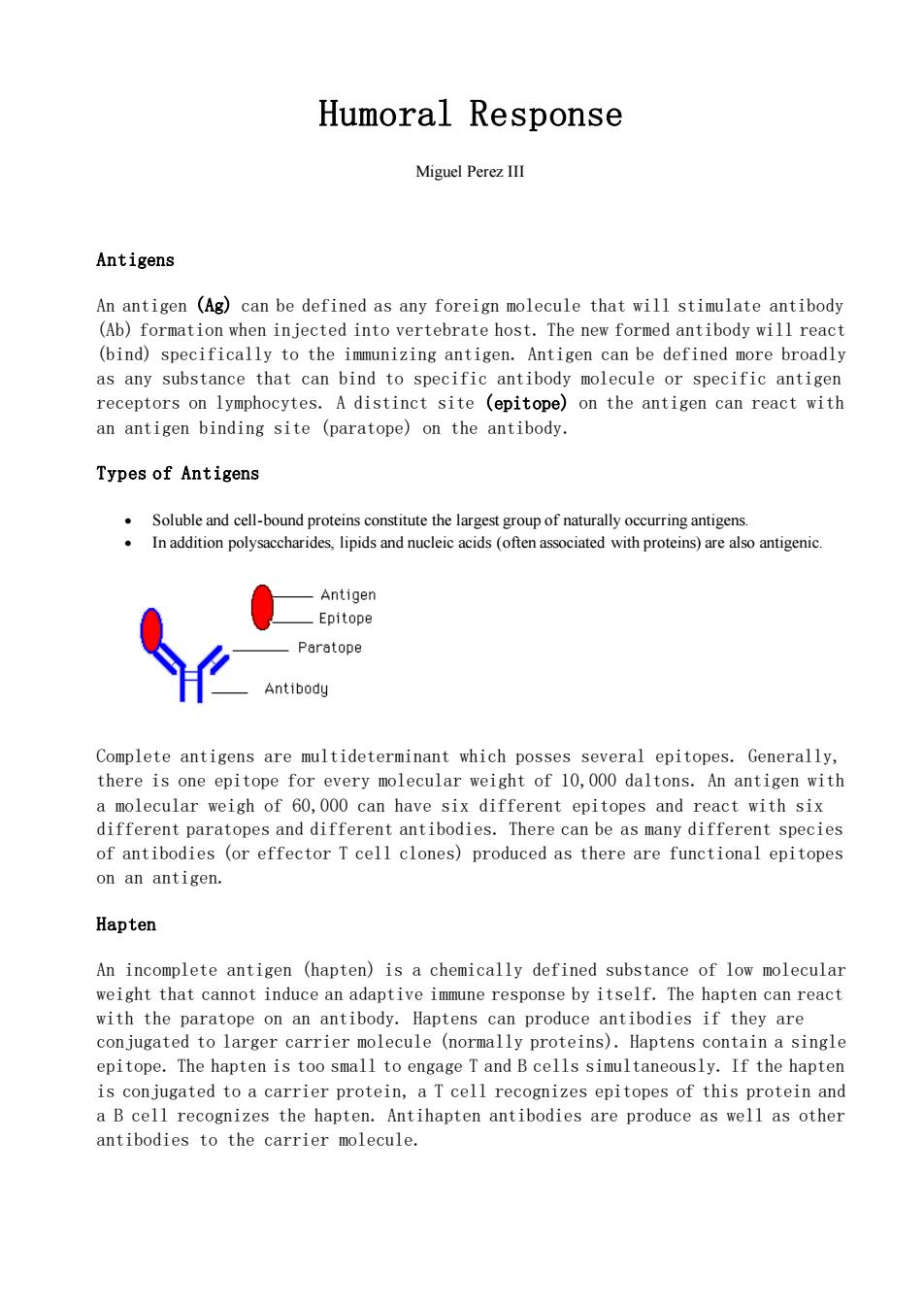
Humoral Response Miguel Perez IⅢ Antigens can be defined as any foreign molecule that will stimulate antibody into vertbrate host.e (bind)specifically to the immunizing antigen.Antigen can be defined more broadly as any substance that can bind to specific antibody molecule or specific antigen receptors on lymphocytes.A distinct site (epitope)on the antigen can react with an antigen binding site (paratope)on the antibody Types of Antigens .Soluble and cell-bound proteins constitute the largest group of naturally occurring antigens. In addition polysaccharides,lipids and nucleic acids (often associated with proteins)are also antigenic. Antiger Epitope Paratope Antibody Complete antigens are multideterminant which posses several epitopes.Generally, there is one epitope for every molecular weight of 10,000 daltons.An antigen with can have topes and r react with six of antibodies (or effector T cell clones)produced as there are functional epitopes on an antigen. Hapten An incomplete antigen (hapten)is a chemically defined substance of low molecular weight that camnot induce an adaptive ime response by itself The hapten can react with the paratope on an antibody.Haptens can produce antibodies if they are con jugated to larger carrier molecule (normally proteins).Haptens contain a single epitope.The hapten is too small to engage T and B cells simultaneously.If the hapten is conjugated to a carrier protein,a T cell recognizes epitopes of this protein and a B cell izes the hapten Antihapten antibodies are produce as well as other antibodies to the carrier molecule
Humoral Response Miguel Perez III Antigens An antigen (Ag) can be defined as any foreign molecule that will stimulate antibody (Ab) formation when injected into vertebrate host. The new formed antibody will react (bind) specifically to the immunizing antigen. Antigen can be defined more broadly as any substance that can bind to specific antibody molecule or specific antigen receptors on lymphocytes. A distinct site (epitope) on the antigen can react with an antigen binding site (paratope) on the antibody. Types of Antigens • Soluble and cell-bound proteins constitute the largest group of naturally occurring antigens. • In addition polysaccharides, lipids and nucleic acids (often associated with proteins) are also antigenic. Complete antigens are multideterminant which posses several epitopes. Generally, there is one epitope for every molecular weight of 10,000 daltons. An antigen with a molecular weigh of 60,000 can have six different epitopes and react with six different paratopes and different antibodies. There can be as many different species of antibodies (or effector T cell clones) produced as there are functional epitopes on an antigen. Hapten An incomplete antigen (hapten) is a chemically defined substance of low molecular weight that cannot induce an adaptive immune response by itself. The hapten can react with the paratope on an antibody. Haptens can produce antibodies if they are conjugated to larger carrier molecule (normally proteins). Haptens contain a single epitope. The hapten is too small to engage T and B cells simultaneously. If the hapten is conjugated to a carrier protein, a T cell recognizes epitopes of this protein and a B cell recognizes the hapten. Antihapten antibodies are produce as well as other antibodies to the carrier molecule
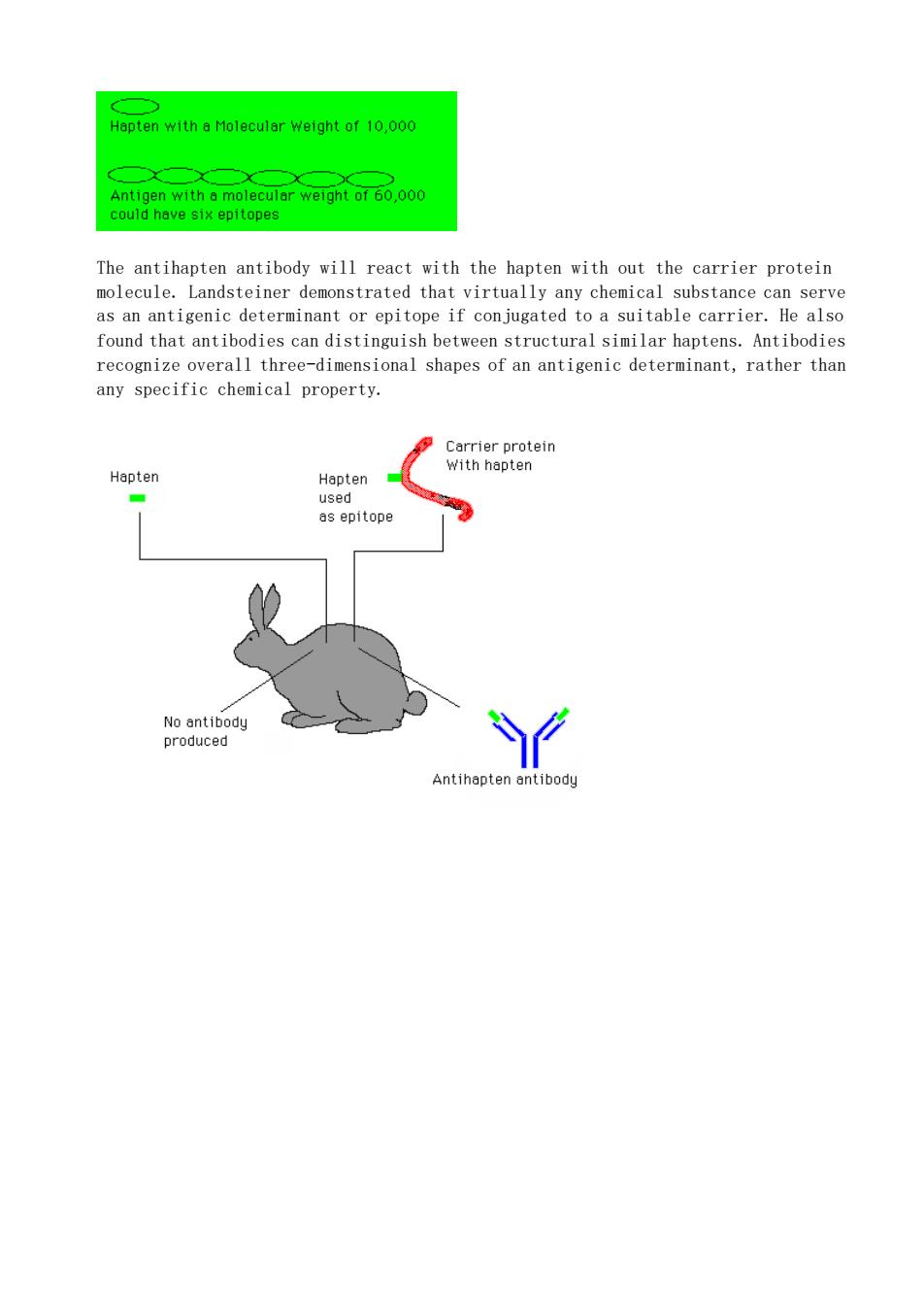
epten withaMolecular weight of 10,000 The antihapten antibody will react with the hapten with out the carrier protein molecule.Landsteiner demonstrated that virtually any chemical substance can serve as an ant tigenic determinant or epitope if conjugated toa suitable carrier.He alse found that antibodies can distinguish between structural similar haptens.Antibodies recognize overall three-dimensional shapes of an antigenic determinant,rather than any specific chemical property. Carrier protein with hapten Hapten Hapten No antibody produced Antihapten antibody
The antihapten antibody will react with the hapten with out the carrier protein molecule. Landsteiner demonstrated that virtually any chemical substance can serve as an antigenic determinant or epitope if conjugated to a suitable carrier. He also found that antibodies can distinguish between structural similar haptens. Antibodies recognize overall three-dimensional shapes of an antigenic determinant, rather than any specific chemical property
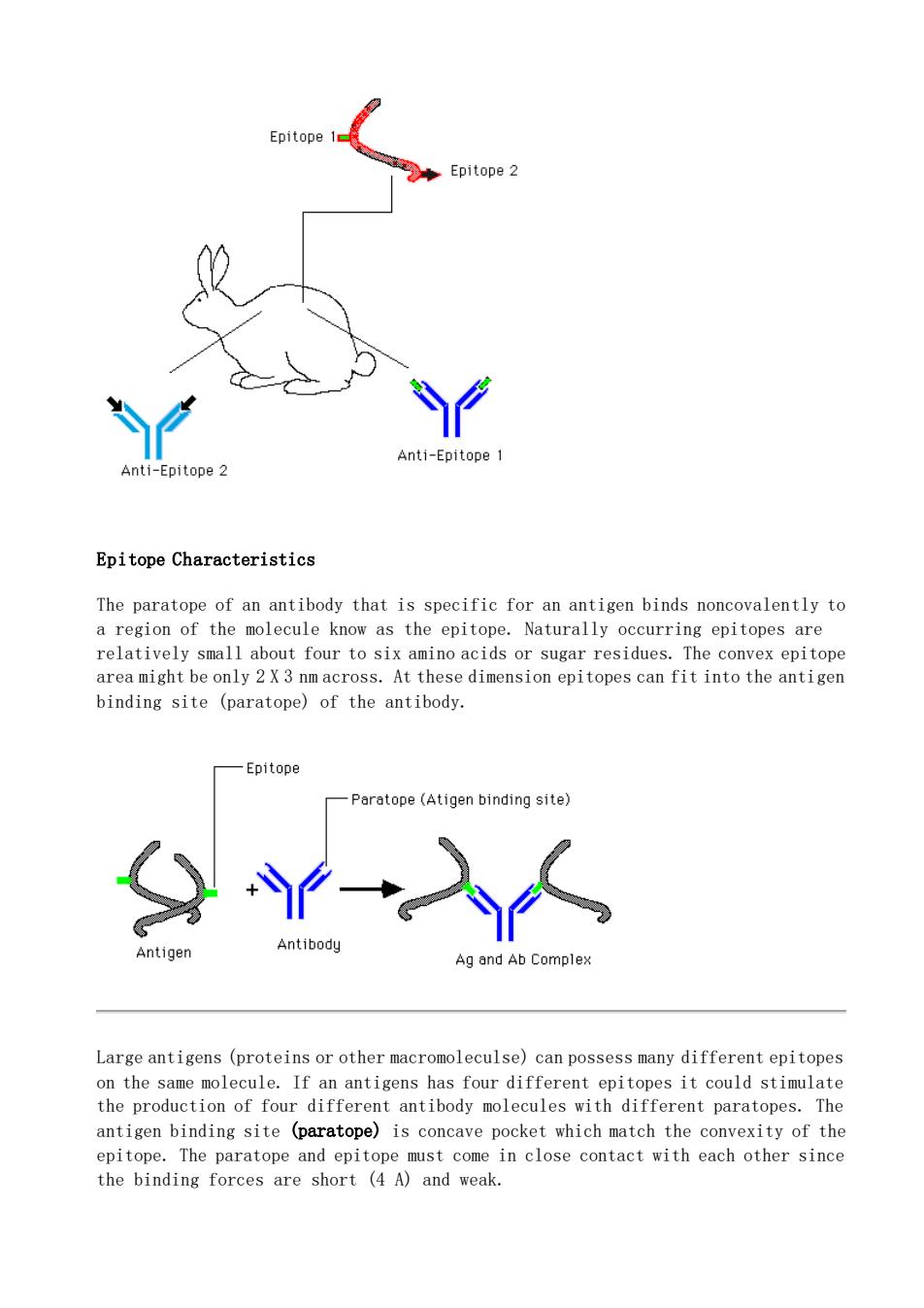
Epitope 2 Anti-Epitope 1 Anti-Epitope 2 Epitope Characteristics The paratope of an antibody that is specific for an antigen binds noncovalently to a region of the molecule know as the epitope.Naturally occurring epitopes are relatively small about four to six amino acids or sugar residues.The convex epitope area might be only 2 X 3 nm across.At these dimension epitopes can fit into the antigen binding site (paratope)of the antibody. -Epitope -Paratope (Atigen binding site) ntigen Antibody Ag and Ab Comi Large antigens (proteins or other macromoleculse)can possess many different epitopes on the it could stimula at antigen binding site (paratope)is concave pocket which match the convexity of the epitope.The paratope and epitope must come in close contact with each other since the binding forces are short (4 A)and weak
Epitope Characteristics The paratope of an antibody that is specific for an antigen binds noncovalently to a region of the molecule know as the epitope. Naturally occurring epitopes are relatively small about four to six amino acids or sugar residues. The convex epitope area might be only 2 X 3 nm across. At these dimension epitopes can fit into the antigen binding site (paratope) of the antibody. Large antigens (proteins or other macromoleculse) can possess many different epitopes on the same molecule. If an antigens has four different epitopes it could stimulate the production of four different antibody molecules with different paratopes. The antigen binding site (paratope) is concave pocket which match the convexity of the epitope. The paratope and epitope must come in close contact with each other since the binding forces are short (4 A) and weak
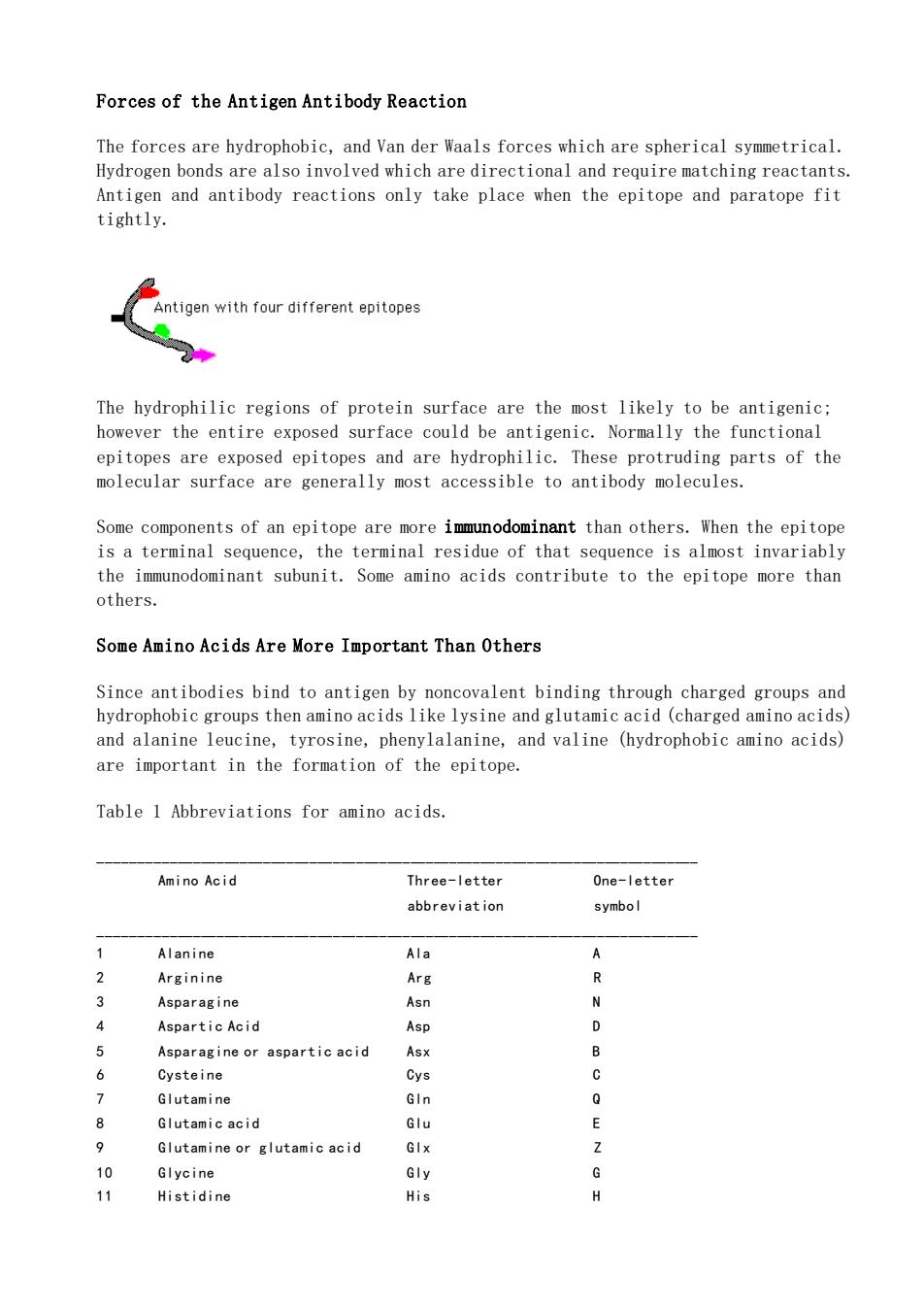
Forces of the Antigen Antibody Reaction The forces are hydrophobic,and Van der Waals forces which are spherical symmetrical. Hydrogen bonds are also involved which are directional and require matching reactants Antigen and antibody reactions only take place when the epitope and paratope fit tightly. Antigen with four different epitopes 》 The hydrophilic regions of protein surface are the most likely to be antigenic: however the entire exposed surface could be antigenic.Normally the functional epitopes are exposed epitopes and are hydrophilic.These protruding parts of the molecular surface are generally most accessible to antibody molecules. Some components of an epitope are more immunodominant than others.When the epitope is a terminal sequence,the terminal residue of that sequence is almost invariably the immunodominant subunit.Some amino acids contribute to the epitope more than others. Some Amino Acids Are More Important Than Others Since antibodies bind to antigen by noncovalent binding through charged groups and hydrophobi c groups then amino acids like lysine and glutamic id (charged amino acid and alanine leucine,tyrosine,phenylalanine,and valine (hydrophobic amino acids) are important in the formation of the epitope. Table 1 Abbreviations for amino acids. Amino Acid Three-letter One-letter abbreviation Alanine Ala Arginine Arg R Asparagine Asn M Aspartic Acid Asp 0 Asparagine or aspartic acid Asx 6 Cysteine Cys Glutamine GIn Glutamic acid Glu E Glutamine or glutamic acid GIx 10 Glycine Gly Histidine His H
Forces of the Antigen Antibody Reaction The forces are hydrophobic, and Van der Waals forces which are spherical symmetrical. Hydrogen bonds are also involved which are directional and require matching reactants. Antigen and antibody reactions only take place when the epitope and paratope fit tightly. The hydrophilic regions of protein surface are the most likely to be antigenic; however the entire exposed surface could be antigenic. Normally the functional epitopes are exposed epitopes and are hydrophilic. These protruding parts of the molecular surface are generally most accessible to antibody molecules. Some components of an epitope are more immunodominant than others. When the epitope is a terminal sequence, the terminal residue of that sequence is almost invariably the immunodominant subunit. Some amino acids contribute to the epitope more than others. Some Amino Acids Are More Important Than Others Since antibodies bind to antigen by noncovalent binding through charged groups and hydrophobic groups then amino acids like lysine and glutamic acid (charged amino acids) and alanine leucine, tyrosine, phenylalanine, and valine (hydrophobic amino acids) are important in the formation of the epitope. Table 1 Abbreviations for amino acids. _____________________________________________________________________________ Amino Acid Three-letter One-letter abbreviation symbol _____________________________________________________________________________ 1 Alanine Ala A 2 Arginine Arg R 3 Asparagine Asn N 4 Aspartic Acid Asp D 5 Asparagine or aspartic acid Asx B 6 Cysteine Cys C 7 Glutamine Gln Q 8 Glutamic acid Glu E 9 Glutamine or glutamic acid Glx Z 10 Glycine Gly G 11 Histidine His H
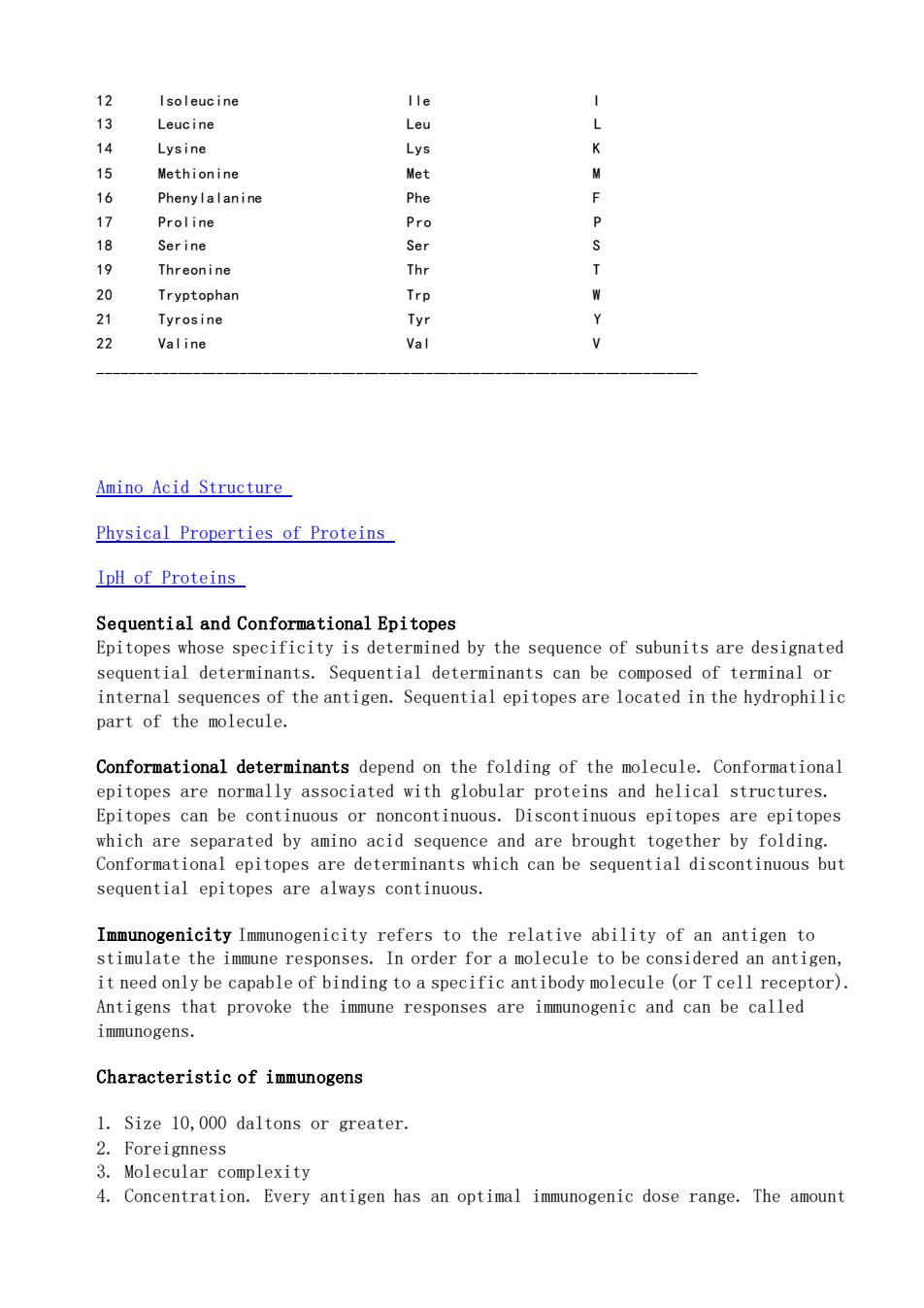
12 Isoleucine 。 13 Leucine Leu 14 Lysine Lys K Methionine Phenylalanine 17 Proline Pro Serine Ser 10 Threonine Thr Tryptophar 2 Tyrosine 22 Val ine Val Amino Acid Structure Physical Properties of Proteins IpH of Proteins Sequential and Conformational Epitopes Epitopes whose specificity is determined by the sequence of subunits are designated sequential determinants. Sequential determinants can be composed of terminal 0 internal sequences of the antigen.Sequential epitopes are located in the hydrophilic part of the molecule. Conformational determinants depend on the folding of the molecule.Conformational epitopes are normally associated with globular proteins and helical structures. Epi opes can be continuous or noncontinuous.Discontinuous epitopes are epitopes which are separated by amino acid sequence and are brought together by folding. Conformational epitopes are determinants which can be sequential discontinuous but sequential epitopes are always continuous. Immunogenicity Immunogenicity refers to the relative ability of an antigen to stimulate the immune responses.In order for a molecule to be considered an antigen it need only be capable f hind ing to a specific antibody molecule(or Tcellr ptor) Antigens that provoke the immune responses are imnogenic and can be called Immunogens. Characteristic of immunogens 1.Size 10,000 daltons or greater. 2.Foreignness 3.Molecular complexity 4.Concentration.Every antigen has an optimal immunogenic dose range.The amount
12 Isoleucine Ile I 13 Leucine Leu L 14 Lysine Lys K 15 Methionine Met M 16 Phenylalanine Phe F 17 Proline Pro P 18 Serine Ser S 19 Threonine Thr T 20 Tryptophan Trp W 21 Tyrosine Tyr Y 22 Valine Val V _____________________________________________________________________________ Amino Acid Structure Physical Properties of Proteins IpH of Proteins Sequential and Conformational Epitopes Epitopes whose specificity is determined by the sequence of subunits are designated sequential determinants. Sequential determinants can be composed of terminal or internal sequences of the antigen. Sequential epitopes are located in the hydrophilic part of the molecule. Conformational determinants depend on the folding of the molecule. Conformational epitopes are normally associated with globular proteins and helical structures. Epitopes can be continuous or noncontinuous. Discontinuous epitopes are epitopes which are separated by amino acid sequence and are brought together by folding. Conformational epitopes are determinants which can be sequential discontinuous but sequential epitopes are always continuous. Immunogenicity Immunogenicity refers to the relative ability of an antigen to stimulate the immune responses. In order for a molecule to be considered an antigen, it need only be capable of binding to a specific antibody molecule (or T cell receptor). Antigens that provoke the immune responses are immunogenic and can be called immunogens. Characteristic of immunogens 1. Size 10,000 daltons or greater. 2. Foreignness 3. Molecular complexity 4. Concentration. Every antigen has an optimal immunogenic dose range. The amount

of antigen can be quite critical.Too much or too little antigen might not elicit an immune response Adjuvants The response to antigens can be increased by use of adjuvants.Ajuvants contribute to greater and prolonged antibody production and increased effector cell counts. Ajuvants can react in several ways: 1.Alter the distribution and persistence of antigen within the host. 2.Stimulate lymphocytes production non specifically. 3.Activate mac opha 4.Alter traffic of circulating lymphocytes. Freund adjuvant consist of oil and Mycobaterium tuberculosis.This adjuvant can not be use in humans. Routes of injection 1 Into the muscle (intramuscular IM) 2.Under the skin (subcutaneous) 3.Into a vein (intravenous IV) 4.Into the abdominal cavity (intrapeitoneal IP) 5.Into the skin (intradermal,Usually multiple injections) Antigen presentation and epitope recognition. Myeloma Protein Antibody Structure Five different Classes of Antibodies Return This page is maintained by the Natural Toxins Research Center at Texas A&M University Kingsville
of antigen can be quite critical. Too much or too little antigen might not elicit an immune response. Adjuvants The response to antigens can be increased by use of adjuvants. Ajuvants contribute to greater and prolonged antibody production and increased effector cell counts. Ajuvants can react in several ways: 1. Alter the distribution and persistence of antigen within the host. 2. Stimulate lymphocytes production non specifically. 3. Activate macrophages. 4. Alter traffic of circulating lymphocytes. Freund adjuvant consist of oil and Mycobaterium tuberculosis. This adjuvant can not be use in humans. Routes of injection 1. Into the muscle (intramuscular IM) 2. Under the skin (subcutaneous) 3. Into a vein (intravenous IV) 4. Into the abdominal cavity (intrapeitoneal IP) 5. Into the skin (intradermal, Usually multiple injections) Antigen presentation and epitope recognition. Myeloma Protein Antibody Structure Five different Classes of Antibodies Return This page is maintained by the Natural Toxins Research Center at Texas A&M University - Kingsville